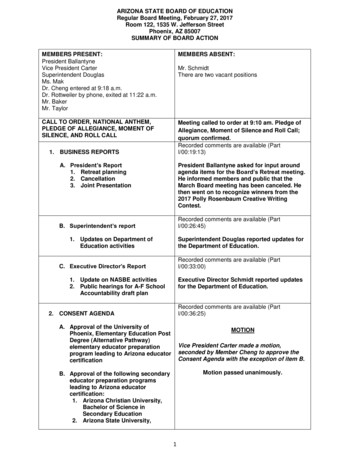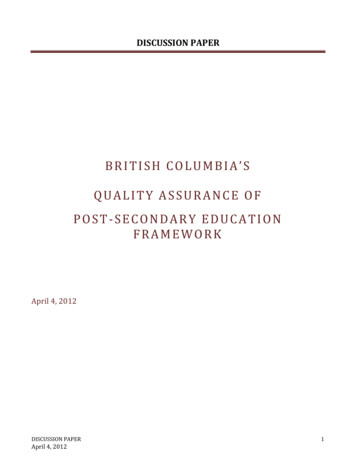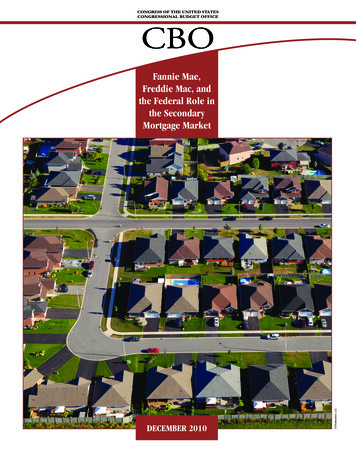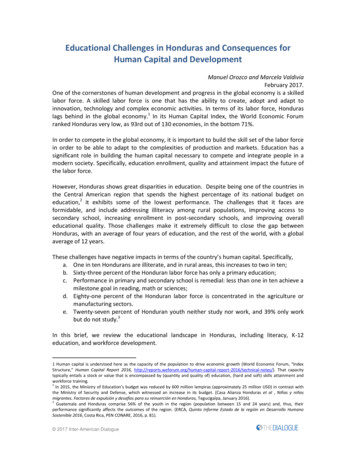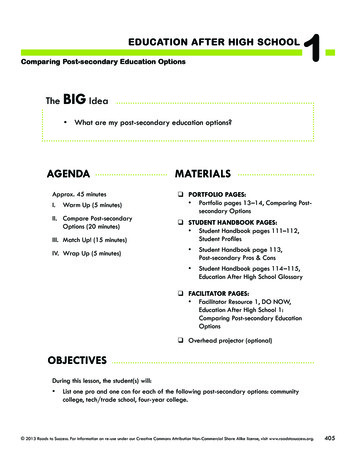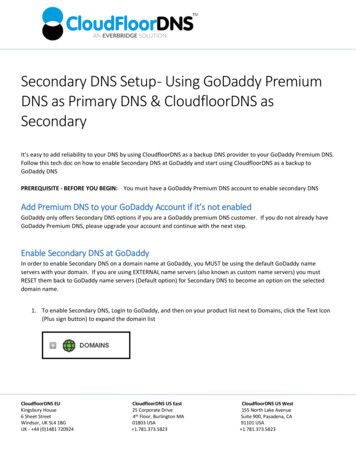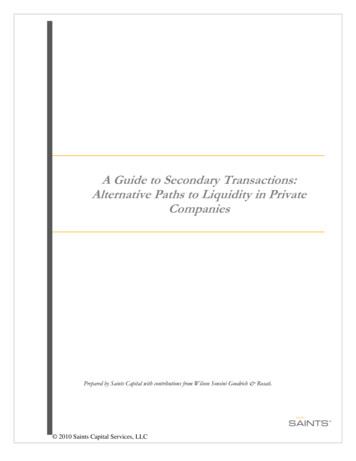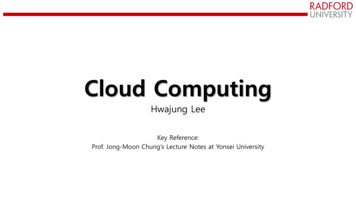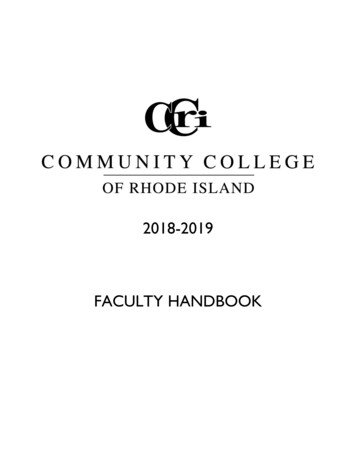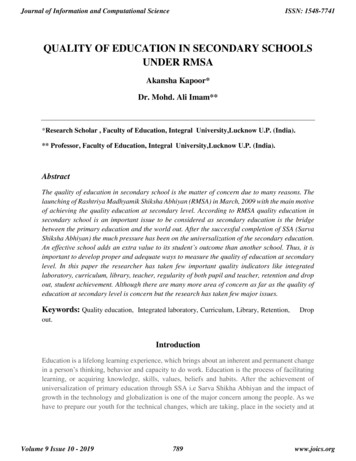
Transcription
Journal of Information and Computational ScienceISSN: 1548-7741QUALITY OF EDUCATION IN SECONDARY SCHOOLSUNDER RMSAAkansha Kapoor*Dr. Mohd. Ali Imam***Research Scholar , Faculty of Education, Integral University,Lucknow U.P. (India).** Professor, Faculty of Education, Integral University,Lucknow U.P. (India).AbstractThe quality of education in secondary school is the matter of concern due to many reasons. Thelaunching of Rashtriya Madhyamik Shiksha Abhiyan (RMSA) in March, 2009 with the main motiveof achieving the quality education at secondary level. According to RMSA quality education insecondary school is an important issue to be considered as secondary education is the bridgebetween the primary education and the world out. After the successful completion of SSA (SarvaShiksha Abhiyan) the much pressure has been on the universalization of the secondary education.An effective school adds an extra value to its student’s outcome than another school. Thus, it isimportant to develop proper and adequate ways to measure the quality of education at secondarylevel. In this paper the researcher has taken few important quality indicators like integratedlaboratory, curriculum, library, teacher, regularity of both pupil and teacher, retention and dropout, student achievement. Although there are many more area of concern as far as the quality ofeducation at secondary level is concern but the research has taken few major issues.Keywords: Quality education, Integrated laboratory, Curriculum, Library, Retention,Dropout.IntroductionEducation is a lifelong learning experience, which brings about an inherent and permanent changein a person’s thinking, behavior and capacity to do work. Education is the process of facilitatinglearning, or acquiring knowledge, skills, values, beliefs and habits. After the achievement ofuniversalization of primary education through SSA i.e Sarva Shikha Abhiyan and the impact ofgrowth in the technology and globalization is one of the major concern among the people. As wehave to prepare our youth for the technical changes, which are taking, place in the society and atVolume 9 Issue 10 - 2019789www.joics.org
Journal of Information and Computational ScienceISSN: 1548-7741work at a rapid pace. The secondary and higher secondary education play an important role infulfilling these objectives. At this point it has been realized that the time has come to focus onuniverasalization of secondary and senior secondary education. Considering this for the uplift ofthe society and for making better tomorrow, the government of India has announced the schemeRMSA for universalization of secondary education. The basic motive of the scheme is to bridgethe gap between the primary and secondary education. Secondary education prepares the studentsfor higher education whereas the senior secondary education prepares them for the world of work.Secondary education constitutes class IX-X with an age group 14 to 16 years whereas seniorsecondary constitute classes XI-XII with an age group of 16 to 18 years. With the liberalization ofthe Indian economy, there is a need to improve the quality of education, to reduce poverty. It isimportant for the development of the country. In order to achieve this it is important that thechildren who have completed their primary education should acquire the higher knowledge andskills. The earning of the secondary certificate holder is much higher than the person who hasstudied only till elementary level.The Rashtriya Madhayamik Shiksha Abhiyan (RMSA) is a committee which is been framed bythe government of India to universalize the quality education at secondary level and seniorsecondary level. The main motive of the committee is to impart quality education by meeting thebasic needs at this stage in terms of infrastructure, development of curriculum, learning resources,qualification of teachers, teachers training, ICT, teaching-learning material, art and craft, etc. Thisscheme of RMSA focuses on the overall development of the child whether it is in sports, art, musicetc. It believes in vocational training for the all, so that it trained the children for the world outside.Objectives of the studyThe present study has been conducted with the following objectives:1. To study the indicators for quality education in secondary schools under RMSA.2. To study the quality of education with reference to Integrated laboratory Curriculum Library Regularity of the teachers and the students.3. To study the quality of education with respect to Availability of the trained teachers. Pupil-teacher ration4. To study the change in student’s achievement and dropout /retention ratio afterimplementation of RMSA.Research Method: Considering the nature of the present study the Descriptive Survey Methodwas used.Volume 9 Issue 10 - 2019790www.joics.org
Journal of Information and Computational ScienceISSN: 1548-7741Population of the study: The government secondary schools from five districts of centralUttar-Pradesh, Lucknow, Hardoi, Kanpur, Barabanki and Sitapur are considered for the study.Tools used: The self- made questionnaire and observation method is been used to study theobjectives of the study.Indicator for quality education in secondary schools under RMSAThe major concern of this study is to find the factors that are responsible for the quality ofeducation in secondary schools under RMSA. As in computers there are three devices input device,processing device and output device, similarly the quality indicators of the secondary educationcan be divided in three parts i.e. input , process and output. Inputs include all those factors, whichare required for the proper functioning of education at secondary level like financial, infrastructuraland human resources. The infrastructure includes laboratories, libraries, art and craft room, girl’sactivity rooms, toilet, drinking water etc under RMSA. Human resource includes the factors liketeacher, principal, students, parents and all those people who are involved directly or indirectly inthe education process. It also include the educational qualification of the teachers, subjectknowledge and their teaching experience. According to many research scholars, many programshave been established to maintain the quality of education at national, regional and local level.Quality of education is the matter of concern at every level because it is one of the major aspectthrough which the educational goals can be achieved. The process indicator is the one, whichreveals the classroom reality and are difficult to measure. The classroom reality are difficult tomeasure. The methods evaluation include both the quantitative and qualitative information.Quantitative indicators include enrolment ratios, teacher’s qualification. According to UNESCOin 2005, the Central Board of Secondary Education (CBSE) in 2005 and Rashtriya MadhyamikShiksha Abhiyan (RMSA) in 2009 focuses on the increase in the enrolment of the student. This isonly possible if the quality of education is imparted at all the level. Quality at this level can beaccessed by the increase in enrolment ratio and increase in 100% result of the students in the publicexaminations or the number of candidates, which got 1st division in Board examination. Thus theseindicators whether qualitative or quantative are the measure which helps in the upgrading theschool. The last process is output which includes the student achievement, dropout rates, at variousexamination level. If we want to achieve the desired output, input and process part should behandled with utmost care. The researcher after analyzing the quality indicators at secondary levelgiven by Rashriya Madhiyamik Shiksha Abhiyan, has taken few indicators into consideration forthe research.Major concern for quality education in secondary schools under RMSAINPUTVolume 9 Issue 10 - 2019PROCESS791OUTPUTwww.joics.org
Journal of Information and Computational ScienceISSN: 1548-7741Integrated Laboratory: It is been observed that the main reason for the failure of the studentis mathematics and science is their limited understanding of the concepts. This problem was raisedby the NCF in 2005.and the group of people teaching science suggested that these subjects can bebetter understood when they are been shown to the student or the students perform experimentsthemselves. As it is been said that I hear I forgot, I see I remember, I do I understand. Thus for thebetter understanding of the students the RMSA has put emphasis on the integrated laboratory andworkshops to promote experimental culture by reducing the importance of external examination.In the research conducted the researcher found that out of 10, 8 secondary schools have theintegrated laboratory. But the irony is that the laboratories are not well equipped the materials.Curriculum: The designing and formulation of the curriculum is one of the importantresponsibilities of the national and state level bodies working in the field of education. The NPE(National policy of Education), 1986 and POA (program of action), 1992 view the curriculum asframework for establishing the national system of education, which has certain core educationalpattern which is common for all. This standard education system was considered of greatimportance in the country like India where each state has different language. The commoneducation system broadens the horizon for the students to study in any part of the country. Afterthe approval by the central advisory board of education, the national curriculum framework 2005was designed by the NCERT after lot of background work. Similar structure needs to be createdin all the states with new syllabus and books according to the state level. Majority of the stateshave finished this task where as those who have not are under the process of completing theexercise. The national focus group on work and education, is been designed as a part to revise theNational curriculum framework (NCF)-2005, expressed it is about the designing of the curriculum.According to sit there are many who have never gone to school for formal learning are expert intheir skilled work and are earning handsome amount of money, whereas those who have taken theformal education lack necessary skill. Although they have got the formal education and have spentthe major time in receiving it are unable to implement it practically .Thus the RMSA emphasis onthe vocational education should be added as a part of a curriculum , so that the student have thepractical knowledge how to use their skills in the world outside. The detail framework of “workand education” for school education should be developed by NCERT.Library: The library is considered as a very important under RMSA. According to RMSA, theICT resource room and the library of the school can be housed in one room, which is big enough,or they may be put in the adjacent room. All library operation should be computerized. Thereshould be a permanent librarian cum computer instructor to take care of the library as well as theICT. Proper arrangement of books in the shelf with the reference book should be present in thelibrary, which can be accessible by the teacher and the students any time. The practical knowledgeshould be given to the students through computer.Volume 9 Issue 10 - 2019792www.joics.org
Journal of Information and Computational ScienceISSN: 1548-7741Regularity of students and teachers: Regularity is one of the major aspects for the growthof the student. If a child is regular to the school, his or her performance level is much better. Theunderstanding level of the student increases if the child is coming to the school daily. Whereas theregularity is one the major aspect for the teachers as well, the regularity of the teacher leaves agreat impact on the understanding level of the students. If the teacher is regular to the school, shecan plan her lesson in a better way and can understand her student’s weakness and strength. Thuscan help the students to perform better in there exams. As the main motive of RashtriyaMadhyamik Shiksha Abhiyan is to impart the quality education at secondary level this factor paysa major role as all the effort whether infrastructural or teaching goes in vain if the student will notcome to the school. The benefits can only be transferred if the students are regular to the school.It is been found there are many reasons for irregularity like distance of the school, source ofearning, lack of awareness among the lower and the weaker section of the society.Teachers: Teacher is the most important component of the school teaching. At secondary andhigher secondary level the subject wise teachers are required to improve the quality of education.Beside this special teacher for physical education, art and craft, music, dance is also required to beappointed. It is necessary to upgrade the quality of teacher through in-service educationprogrammes, bachelor in education B.Ed. There are many regions in Uttar Pradesh and even acrossthe country, where it is difficult to find good teachers, thus these training sessions are of great help.It is also important to develop a platform where the teacher can share their experience and theproblem faced. The teacher should be aware about the changes in the curriculum and other change,which are brought in from time to time by CBSE. It is difficultTo find the good teacher, which are good with their concepts. The graph which is been made belowshows the availability of the teachers in the core subjects like mathematics, science, social scienceand languages. As the graph shows that there is the maximum availability of the teachers followedby social science, then science and good mathematics teachers are hard to find who can explainthe proper mathematical concepts to the students. According to RMSA the pupil teacher ratioshould be 1:25 but actually this is not the situation in all the school specially government schoolwhere the PTR is very high. Due to the high number of PTR ratio the understanding level of thestudents are not up to mark as the teacher is not able to concentrate on each student and the qualityof education is not imparted from teacher to the student.Volume 9 Issue 10 - 2019793www.joics.org
Journal of Information and Computational ScienceISSN: 1548-7741Figure 1: Availability of teachers in core subjects in secondary school (Govt.schools) under RMSAMathematicsScienceSocial sciencesLanguagesFigure 2: PTR of core subject in the secondary schools under ocial sciencesLanguagesStudent’s achievement:In order to control the stress of the examination, it is important to reconstruct and redesign theexamination pattern with lot of flexibility so that the students can score more. The student canachieve through continuous and comprehensive evaluation. As it is been felt that an examination,which is conducted as a part of curriculum, cannot judge the ability of the student, thus it is aVolume 9 Issue 10 - 2019794www.joics.org
Journal of Information and Computational ScienceISSN: 1548-7741considered as a continuous process. The school-based assessment by teacher is the common wayof evaluation all across the country. According to RMSA, the NCERT and state level nodalagencies should take steps through workshop and other mode of dissemination of information. Thecurrent structure of the examination leads to rote learning of the students rather than theunderstanding of the concepts. The long answer question should be replaced with multiple-choicequestion to test the understanding level of the student.It is been suggested by national policy of education (NPE), to develop the national evaluationorganization (NEO) to control the quality of education by organizing the worldwide tests tocompare the performance of the students of different state or within the state. There should be acommon admission tests for the admission in graduate courses in colleges for getting the degreefor job. The budget for the same should be initially used from the budget sanction for theexamination department. The main motive is to make the students examination friendly so thatthere will be no phobia for it. The government has made many changes in the evaluation patternthe only concern is to see that whether they are executed in the way they are designed.Figure 3: Pass percentage at secondary 016Retention /Dropout rate: There are many reasons for the retention of the students at thesecondary level like inadequate learning environment to attract students to school, non-availabilityof infra structural facilities etc. As RMSA was announced in 2009 where much importance is givento impart the quality education to the students at secondary. The graph shown gives the clearpicture of the drop ratio in the consecutive year after the announcement of RMSA by thegovernment of India. This graph clearly shows that there is a continuous decrease in the dropoutrate in all these years. This shows that after RMSA the dropout rate has decreased as it works onthe quality of education.Volume 9 Issue 10 - 2019795www.joics.org
Journal of Information and Computational ScienceISSN: 1548-7741Figure 4: Dropout rate in secondary school under 2015-162016-17-2-4-6ConclusionAfter the completion of the Sarva Shiksha Abhiyan i.e the universalisation ofPrimary education the need for the higher education at secondary and senior secondary is felt.Thus, the governments of India in 2009 announce the scheme Rashtriya Madhiyamik ShikshaAbhiyan for universalization of secondary level. It acts as a bridge between the primary andSecondary education. The main emphasis of RMSA is on imparting quality education to theStudents at secondary level. In the paper, the researcher has taken few aspects to measure theQuality of education at secondary level. The RMSA recommends about the critically examineOf lateral and vertical linkage between the curriculum at the primary and secondary level.The proper use of teaching learning methods like library, laboratory should be their where theStudent can perform experiments, or the demonstration can be shown by the teacher. It is beenObserved that the student score usually less marks in science and mathematics due to lack of theirConceptual understanding. The proper usage of the laboratory where the concept will be thoughThrough demonstration method will of great help to the students One of the important aspect ofRMSA programme is the provision for in-service training per teacher per year, inductionProgram and the raining of new technology and their usage by the teacher to enhance theirTeaching skills. In this, regard RMSA in year 2011-2012 induction training (for newly appointedTeachers) was provided to only 7737 teachers out of 41600 number of proposed teachers, inService training was given only to 310,774 whereas the proposed number was 827,442. ManyTeachers have not attended the training progamme. To make the teaching more effective, teacherVolume 9 Issue 10 - 2019796www.joics.org
Journal of Information and Computational ScienceISSN: 1548-7741Can be tested as a diagnostic tool first. This will help to teachers to identify the area of theirWeakness and strength and according they can be trained. With the availability of ICT facilitiesMore innovative methods can be adopted for teaching. When the issue related to qualityEducation is raised at secondary level the discussed veered to enrichment programs such asExcursion trips for teacher and students, science exhibitions, art and craft class, library room,Dance and music class. This quality related inputs are not the same for all the students as theUnderstanding level of the students varies. Thus, there are many quality measures, which areGiven RMSA, which needs to be followed for the better results.Educational Implication of the studyThe implications are based on the findings of the study are given below:1. The finding of the study reveals integrated laboratories have been made in majority of thesecondary schools of the district, but these laboratories need to be well equipped with thematerial so that it can be of the great help to the students. The laboratory needs to have latestscientific material for better understanding of the students.2. The study indicates that the curriculum, which is designed by the national curriculum framework(NCF), is good enough to increase the understanding level of the student at secondary level. Thedesigned curriculum prepares the student for the outside world, as it act as a connecting linkbetween the higher secondary education and the world outside. It is been found that the vocationaleducation is imparted in only districts. Thus much emphasis should be given to incorporate thevocational education in the curriculum as suggested by RMSA.3. There is a library in almost all the secondary schools, but the proper usage of ICT should bepromoted. The old senior staff should be trained for the same.4. In the study it is been found that regularity of the teachers and the students is one of the majorfactor for the quality education at secondary level. It is found that there are many reasons likefamily conditions, bad company etc of the irregularity of the students to the school.5. The finding shows that the PTR is good, there is no scarcity of the teacher at secondary level.6. The finding also reveals that the good teachers for the core subjects are difficult to find likemathematics and science.7. The study also indicates that in in-service teachers training programs conducted by RMSA areof great help to the teachers. It enhances the teaching learning process. Such programs shouldbe conducted from time to time and should be made the integral part of the curriculum.8. The finding of the study suggests that the student’s achievement level has increased in theconsecutive years after the implementation of RMSA. According to NCERT the long answersquestions should be replaced with the multiple choice questions, so that the students can scorewell.9. The study suggests that there is a reduction in dropout ratio of the students in the consecutiveyears.Volume 9 Issue 10 - 2019797www.joics.org
Journal of Information and Computational ScienceISSN: 1548-7741Suggestions for the present studyThe following are the some suggested problem based on the finding of the study:1. The present study can be conducted in the other districts of central Uttar Pradesh, to study thelevel of quality education.2. The study can be designed to see the impact of ICT on the understanding level of the studentsin these districts.3. The study can be conducted to find the status of vocational education at secondary level.4. The present study can be designed to study the PTR, teachers’ qualification in other districtsof Uttar Pradesh.Acknowledgement: The researcher would like to thank Integral University for the support,participation and encouragement of this research.(IU/R&D/2019-MCN 0007000)References Agarwal, J.C. (2010). Educational reformation in India, Shipra Publication, pp.172- 173.Justice Verma Committee Report, Volume 3, August, 2012.Mukhopadhyay, Marmar. &Parhar, Madhu. (2007). Edited, Education in India Dynamicsof Development, Shipra Publication, pp.238-254.Mukhopadhyay, A. & Sahoo, S. (2012). Does Access to Secondary Education AffectPrimary Schooling? Evidence from India, Discussion Paper No. 6507, Bonn, Germany.Pajankar,V.D. (2012). Indian School Education System A Holistic View, Kunal Books,pp.179-199.Ministry of Human Resource Development. "RashtriyaMadhyamikShikshaAbhiyan".National Informatics Centre. RetrievedGhanshyam Tiwari, Committee of CABE on USE Report, MHRD, India, 2005https://mhrd.gov.in/sites/upload n/sites/upload sites/upload files/mhrd/files/minutes/UP 1.pdfhttp://www.dise.in/Downloads/Paper on Physcial Facilities (Draft prepared for CABE) - /mhrd.gov.in/sites/upload files/mhrd/files/upload ts/nie/dse/deptt/activities/pdfs/Chapter .pdfhttp://rmsa.uk.gov.in/files/RMSA New 22056345.pdfVolume 9 Issue 10 - 2019798www.joics.org
launching of Rashtriya Madhyamik Shiksha Abhiyan (RMSA) in March, 2009 with the main motive of achieving the quality education at secondary level. According to RMSA quality education in secondary school is an important issue to be considered as secondary education is the bridge between the primary education and the world out.
